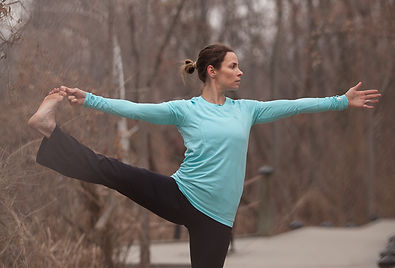







l e a r n d i s c o v e r g r o w

O M J O Y
YOGA & BENEFITS >>
The word yoga comes from the Sanskrit word “yuj,” which means "to join or yoke together," and it brings the body, mind and spirit together creating one harmonious experience. I teach vinyasa yoga with a strong focus on linking breath with movement. The word vinyasa means "synchronized breath movement." This style of yoga is a flowing practice that moves from one posture to another.
8 LIMBS OF YOGA
The 8-Fold Path is usually the first thing we learn in yogic philosophy. Its a definition or road map for the state of being & the practices associated with that state.
1. Yamas :: Moral discipline that regulates our survival instinct
2. Niyamas :: Self-restraint that regulates our personal lives
3. Asana :: Postures that regulate physiology
4. Pranayama :: Breath control that regulates subtle energy
5. Pratyahara :: Sense withdrawal; looking inward
6. Dharana :: One-pointed concentration
7. Dhyana :: Meditation; consciousness expanded
8. Samadi :: Ecstasy, bliss


BENEFITS OF YOGA
Each time you take a yogic breath while in a posture, you do two things: you increase blood flow and pressure on one part of the body and you decrease it on another. Think of how you would go about cleaning a dirty sponge. Don’t you hold it under the water and then repetitively squeeze it in and out? This is precisely what happens to all tissues in the body during yoga, especially the endocrine glands. This massaging, flushing, and cleansing action stimulates endocrine functions to more optimal levels. Anyone who practices yoga regularly can verify that this process is actually tangible, and that increasing levels of confidence and a more positive mental outlook are natural results.
Undoing Stress
Cortisol and adrenalin are hormones that are released in the body as a result of stress. Sustained high levels of these “stress hormones” destroy healthy muscle and bone; slow down healing and normal cell regeneration; co-opt biochemicals needed to make other vital hormones; impair digestion, metabolism, and mental function; interfere with healthy endocrine function; and weaken the immune system. Sustained levels can eventually lead to a host of serious metabolic disorders, from hypertension to cardiac disease. The good news? Yoga reduces cortisol and adrenalin levels in the body by returning it to a physically stress-free state, making it less susceptible to illness and more prone to resiliency and vitality.
Muscular and Cardiovascular Health
As a result of the practice of yoga, your entire muscular system becomes stronger and more elastic, and thus less susceptible to injury. Standing and balancing postures strengthen and lengthen the big muscle groups and floor postures strengthen the muscles that support the spine and head. Flowing from one posture to the next with attention also increases coordination of the musculoskeletal system as a whole. You move more safely and easily and feel more at home in your own body. Finally, the heart, as the largest involuntary muscle of the body, greatly benefits from yogic breathing practices and from the relaxation experienced in the muscles during yoga, allowing the whole cardiopulmonary system to reset to a healthier rhythm.
In addition, whenever your head is lower than your heart—in postures like standing forward bend, Downward Dog, and headstands and shoulder stands—your whole circulatory system gets a rest. The walls of every fluid-containing tube in your body gain a reprieve from the constant fight against gravity. Inversion postures also specifically target the thyroid and pituitary glands, sometimes referred to as the “master glands” because of their role in regulating metabolism and health.
Mind-Body Unity
Neurobiologists have been studying the interaction between the body and the mind, and their findings show what yogis have been saying for thousands of years: functionally, the body and mind are inextricably bound together. The mind is a subtle body and the body is a gross mind. You can think of it like fingers in a glove; when you move your fingers, the glove moves; if you move the glove, your fingers must move also. This insight is the basis for the revolution in psychiatry over the last two decades and the reason why the standard treatment for mental disorders now consists of tinkering with the organic blood chemistry system rather than the psychological and emotional constructs; more often than not, when you go to the psychiatrist, you get a prescription, instead of a dialogue. This interweaving of body and mind also helps to explain yoga’s effectiveness.*
Adapted from Kripalu.org

PRACTICE & DISCIPLINE
"Good or bad it is your practice. To approach perfect practice there is no other way than to accept yourself. To say your practice is bad doesn't help your practice. To say your practice is excellent doesn't help. Your practice is your practice." -Shunryo Suzuki in Not Always So
Whatever it is; Your music, art, poetry, play or yoga. Do it! And keep doing it. It really does work if you keep shaping the landscape you're marching toward. In yogic terms practice means a repetitive action done consciously, that moves us toward a more fully realized experience of ourselves. When you take your practice into everyday life we find a way to participate more wholeheartedly in life and improve our overall well-being through the art of yoga.
In the Yoga Sutras, Patanjali describes practice as containing two important elements: Discipline and Detachment. This means that we work diligently, we keep moving toward the edge of our abilities, while trying to understand that we cannot control the outcome.
